标签:
LevelDB的公共部件并不复杂,但为了更好的理解其各个核心模块的实现,此处挑几个关键的部件先行备忘。
Arena类用于内存管理,其存在的价值在于:
1 class Arena { 2 public: 3 Arena(); 4 ~Arena(); 5 6 // Return a pointer to a newly allocated memory block of "bytes" bytes. 7 char* Allocate(size_t bytes); 8 9 // Allocate memory with the normal alignment guarantees provided by malloc 10 char* AllocateAligned(size_t bytes); 11 12 // Returns an estimate of the total memory usage of data allocated 13 // by the arena (including space allocated but not yet used for user 14 // allocations). 15 size_t MemoryUsage() const { 16 return blocks_memory_ + blocks_.capacity() * sizeof(char*); 17 } 18 19 private: 20 char* AllocateFallback(size_t bytes); 21 char* AllocateNewBlock(size_t block_bytes); 22 23 // Allocation state 24 char* alloc_ptr_; //当前block当前位置指针 25 size_t alloc_bytes_remaining_; //当前block可用内存大小 26 27 // Array of new[] allocated memory blocks 28 std::vector<char*> blocks_; //创建的全部内存块 29 30 // Bytes of memory in blocks allocated so far 31 size_t blocks_memory_; //目前为止分配的内存总量 32 33 // No copying allowed 34 Arena(const Arena&); 35 void operator=(const Arena&); 36 };
Slice的含义和其名称一致,代表了一个数据块,data_为数据地址,size_为数据长度。
Slice一般和Arena配合使用,其仅保持了数据信息,并未拥有数据的所有权。而数据在Arena对象的整个声明周期内有效。
Slice在LevelDB中一般用于传递Key、Value或编解码处理后的数据块。
和string相比,Slice具有的明显好处包括:避免不必要的拷贝动作、具有比string更丰富的语义(可包含任意内容)。
1 class Slice { 2 public: 3 ...... 4 private: 5 const char* data_; 6 size_t size_; 7 };
SkipList称之为跳表,可实现Log(n)级别的插入、删除。跳表是平衡树的一种替代方案,和平衡树不同的是,跳表并不保证严格的“平衡性”,而是采用更为随性的方法:随机平衡算法。
关于SkipList的完整介绍请参见跳表(SkipList),这里借用几幅图做简要说明:
图1.1 跳表
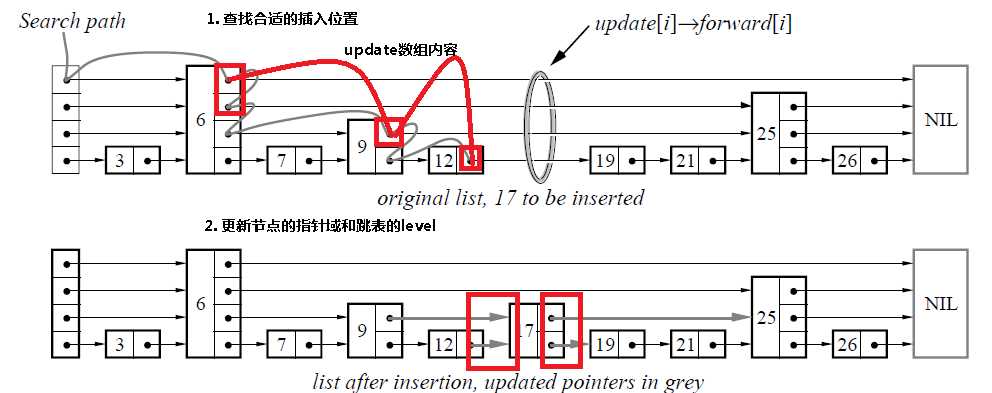
图1.2 查找、插入
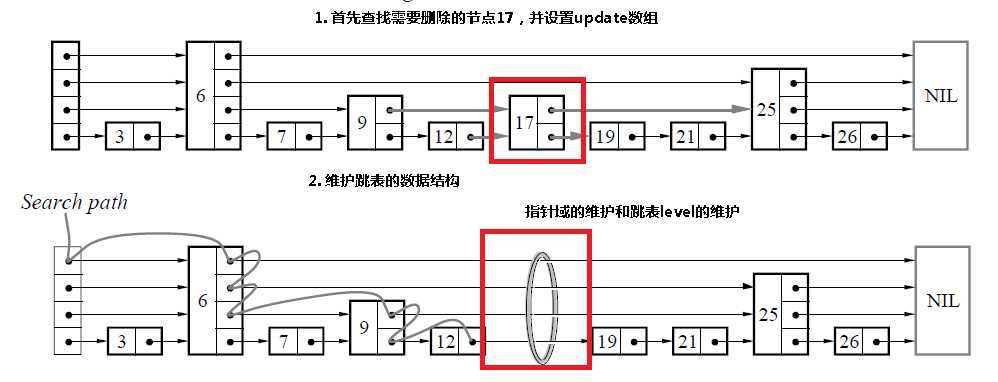
图1.3 查找、删除
分层算法决定了数据插入的Level,SkipList的平衡性如何全权由分层算法决定。极端情况下,假设SkipList只有Level-0层,SkipList将弱化成自排序List。此时查找、插入、删除的时间复杂度均为O(n),而非O(Log(n))。
LevelDB中的分层算法实现如下(leveldb::skiplist::RandomHeight())
1 // enum { kMaxHeight = 12 }; 2 template<typename Key, class Comparator> 3 int SkipList<Key, Comparator>::RandomHeight() 4 { 5 // Increase height with probability 1 in kBranching 6 static const unsigned int kBranching = 4; 7 int height = 1; 8 while (height < kMaxHeight && ((rnd_.Next() % kBranching) == 0)) { 9 height++; 10 } 11 assert(height > 0); 12 assert(height <= kMaxHeight); 13 return height; 14 }
代码1.1 RandomHeight
kMaxHeight 代表Skiplist的最大高度,即最多允许存在多少层,为关键参数,与性能直接相关。修改kMaxHeight ,在数值变小时,性能上有明显下降,但当数值增大时,甚至增大到10000时,和默认的kMaxHeight =12相比仍旧无明显差异,内存使用上也是如此。
为何如此?关键在于while循环中的判定条件:height < kMaxHeight && ((rnd_.Next() % kBranching) == 0)。除了kMaxHeight 判定外,(rnd_.Next() % kBranching) == 0)判定使得上层节点的数量约为下层的1/4。那么,当设定MaxHeight=12时,根节点为1时,约可均匀容纳Key的数量为4^11=4194304(约为400W)。因此,当单独增大MaxHeight时,并不会使得SkipList的层级提升。MaxHeight=12为经验值,在百万数据规模时,尤为适用。
如同二叉树,Skiplist也是有序的,键值比较需由比较器(Compactor)完成。
SkipList对Compactor的要求只有一点:()操作符重载,格式如下:
//a<b返回值小于0,a>b返回值大于0,a==b返回值为0
int operator()(const Key& a, const Key& b) const;
Key与Compactor均为模板参数,因而Compactor亦由使用者实现。LevelDB中,存在一个Compactor抽象类,但该抽象类并没有重载()操作符,至于Compacotr如何使用及Compactor抽象类和此处的Compactor的关系如何请参见MemTable一节。
LevelDB中实现的SkipList并无删除行为,这由其业务特性决定,故此处不提。
查找、插入亦即读、写行为。由图1.2可知,插入首先需完成一次查找动作,随后在指定位置上完成一次插入行为。
LevelDB中的查找、插入行为几乎做到了“无锁”并发,这一点是非常可取的。关于这一点,是本次备忘的重点。先来看查找:
1 template<typename Key, class Comparator> 2 typename SkipList<Key, Comparator>::Node* 3 SkipList<Key, Comparator>::FindGreaterOrEqual(const Key& key, Node** prev) const 4 { 5 Node* x = head_; 6 int level = GetMaxHeight() - 1; 7 while (true) { 8 Node* next = x->Next(level); 9 if (KeyIsAfterNode(key, next)) { 10 // Keep searching in this list 11 x = next; 12 } 13 else { 14 if (prev != NULL) prev[level] = x; 15 if (level == 0) { 16 return next; 17 } 18 else { 19 // Switch to next list 20 level--; 21 } 22 } 23 } 24 }
代码1.2 FindGreaterOrEqual
实现并无特别之处:由最上层开始查找,一直查找到Level-0。找到大于等于指定Key值的数据,如不存在返回NULL。来看SkipList的Node结构:
1 template<typename Key, class Comparator> 2 struct SkipList<Key, Comparator>::Node { 3 explicit Node(const Key& k) : key(k) { } 4 5 Key const key; 6 7 // Accessors/mutators for links. Wrapped in methods so we can 8 // add the appropriate barriers as necessary. 9 Node* Next(int n) { 10 assert(n >= 0); 11 // Use an ‘acquire load‘ so that we observe a fully initialized 12 // version of the returned Node. 13 return reinterpret_cast<Node*>(next_[n].Acquire_Load()); 14 } 15 void SetNext(int n, Node* x) { 16 assert(n >= 0); 17 // Use a ‘release store‘ so that anybody who reads through this 18 // pointer observes a fully initialized version of the inserted node. 19 next_[n].Release_Store(x); 20 } 21 22 // No-barrier variants that can be safely used in a few locations. 23 Node* NoBarrier_Next(int n) { 24 assert(n >= 0); 25 return reinterpret_cast<Node*>(next_[n].NoBarrier_Load()); 26 } 27 void NoBarrier_SetNext(int n, Node* x) { 28 assert(n >= 0); 29 next_[n].NoBarrier_Store(x); 30 } 31 32 private: 33 // Array of length equal to the node height. next_[0] is lowest level link. 34 port::AtomicPointer next_[1]; //看NewNode代码,实际大小为node height 35 };
代码1.3 Node
Node有两个成员变量,Key及next_数组。Key当然是节点数据,next_数组(注意其类型为AtomicPointer )则指向了其所在层及之下各个层中的下一个节点(参见图1.1)。Next_数组的实际大小和该节点的height一致,来看Node的工厂方法NewNode:
1 template<typename Key, class Comparator> 2 typename SkipList<Key, Comparator>::Node* 3 SkipList<Key, Comparator>::NewNode(const Key& key, int height) 4 { 5 char* mem = arena_->AllocateAligned( sizeof(Node) + 6 sizeof(port::AtomicPointer) * (height - 1)); 7 return new (mem) Node(key); //显示调用构造函数,并不常见。 8 }
代码1.4 NewNode
再来看Node的两组方法:SetNext/Next、NoBarrier_SetNext/NoBarrier_Next。这两组方法用于读写指定层的下一节点指针,前者并发安全、后者非并发安全。来看插入操作实现:
template<typename Key, class Comparator> void SkipList<Key, Comparator>::Insert(const Key& key) { // TODO(opt): We can use a barrier-free variant of FindGreaterOrEqual() // here since Insert() is externally synchronized. Node* prev[kMaxHeight]; Node* x = FindGreaterOrEqual(key, prev); // Our data structure does not allow duplicate insertion assert(x == NULL || !Equal(key, x->key)); int height = RandomHeight(); if (height > GetMaxHeight()) { for (int i = GetMaxHeight(); i < height; i++) { prev[i] = head_; } //fprintf(stderr, "Change height from %d to %d\n", max_height_, height); // It is ok to mutate max_height_ without any synchronization // with concurrent readers. A concurrent reader that observes // the new value of max_height_ will see either the old value of // new level pointers from head_ (NULL), or a new value set in // the loop below. In the former case the reader will // immediately drop to the next level since NULL sorts after all // keys. In the latter case the reader will use the new node. max_height_.NoBarrier_Store(reinterpret_cast<void*>(height)); } x = NewNode(key, height); for (int i = 0; i < height; i++) { // NoBarrier_SetNext() suffices since we will add a barrier when // we publish a pointer to "x" in prev[i]. x->NoBarrier_SetNext(i, prev[i]->NoBarrier_Next(i)); prev[i]->SetNext(i, x); } }
代码1.5 Insert
插入行为主要修改两类数据:max_height_及所有level中前一节点的next指针。
max_height_没有任何并发保护,关于此处作者注释讲的很清楚:读线程在读到新的max_height_同时,对应的层级指针(new level pointer from head_)可能是原有的NULL,也有可能是部分更新的层级指针。如果是前者将直接跳到下一level继续查找,如果是后者,新插入的节点将被启用。
随后节点插入方是将无锁并发变为现实:
MemTable是内存表,在LevelDB中最新插入的数据存储于内存表中,内存表大小为可配置项(默认为4M)。当MemTable中数据大小超限时,将创建新的内存表并将原有的内存表Compact(压缩)到SSTable(磁盘)中。
MemTable* mem_; //新的内存表
MemTable* imm_; //待压缩的内存表
MemTable内部使用了前面介绍的SkipList做为数据存储,其自身封装的主要目的如下:
MemTable做为内存表可用于存储Key-Value形式的数据、根据Key值返回Value数据,同时需支持表遍历等功能。
1 class MemTable { 2 public: 3 ...... 4 5 // Returns an estimate of the number of bytes of data in use by this 6 // data structure. 7 // 8 // REQUIRES: external synchronization to prevent simultaneous 9 // operations on the same MemTable. 10 size_t ApproximateMemoryUsage(); //目前内存表大小 11 12 // Return an iterator that yields the contents of the memtable. 13 // 14 // The caller must ensure that the underlying MemTable remains live 15 // while the returned iterator is live. The keys returned by this 16 // iterator are internal keys encoded by AppendInternalKey in the 17 // db/format.{h,cc} module. 18 Iterator* NewIterator(); // 内存表迭代器 19 20 // Add an entry into memtable that maps key to value at the 21 // specified sequence number and with the specified type. 22 // Typically value will be empty if type==kTypeDeletion. 23 void Add(SequenceNumber seq, ValueType type, const Slice& key, const Slice& value); 24 25 // If memtable contains a value for key, store it in *value and return true. 26 // If memtable contains a deletion for key, store a NotFound() error 27 // in *status and return true. 28 // Else, return false. 29 //根据key值返回正确的数据 30 bool Get(const LookupKey& key, std::string* value, Status* s); 31 32 private: 33 ~MemTable(); // Private since only Unref() should be used to delete it 34 35 ...... 36 };
这即所谓的业务形态:以一种全新的,SkipList不可见的形式出现,代表了LevelDB中的一个业务模块。
LevelDB是键值存储系统,MemTable也被封装为KV形式的接口,而SkipList是单值存储结构,因此在插入、读取数据时需完成一次编解码工作。
如何编码?来看Add方法:
1 void MemTable::Add(SequenceNumber s, ValueType type, const Slice& key, const Slice& value) 2 { 3 // Format of an entry is concatenation of: 4 // key_size : varint32 of internal_key.size() 5 // key bytes : char[internal_key.size()] 6 // value_size : varint32 of value.size() 7 // value bytes : char[value.size()] 8 size_t key_size = key.size(); 9 size_t val_size = value.size(); 10 size_t internal_key_size = key_size + 8; 11 //总长度 12 const size_t encoded_len = 13 VarintLength(internal_key_size) + internal_key_size + 14 VarintLength(val_size) + val_size; 15 char* buf = arena_.Allocate(encoded_len); 16 //Internal Key Size 17 char* p = EncodeVarint32(buf, internal_key_size); 18 //User Key 19 memcpy(p, key.data(), key_size); 20 p += key_size; 21 //Seq Number + Value Type 22 EncodeFixed64(p, (s << 8) | type); 23 p += 8; 24 //User Value Size 25 p = EncodeVarint32(p, val_size); 26 //User Value 27 memcpy(p, value.data(), val_size); 28 29 assert((p + val_size) - buf == encoded_len); 30 31 table_.Insert(buf); 32 }
参数传入的key、value是需要记录的键值对,本文称之为User Key,User Value。
而最终插入到SkipList的数据为buf,buf数据和User Key、User Value的转换关系如下:
|
Part 1 |
Part 2 |
Part 3 |
Part 4 |
Part 5 |
|
User Key Size + 8 |
User Key |
Seq Number << 8 | Value Type |
User Value Size |
User Value |
表1 User Key/User Value -> SkipList Data Item
如何解码?来看Get:
1 bool MemTable::Get(const LookupKey& key, std::string* value, Status* s) 2 { 3 Slice memkey = key.memtable_key(); 4 5 Table::Iterator iter(&table_); 6 iter.Seek(memkey.data()); 7 8 if (iter.Valid()) { 9 // entry format is: 10 // klength varint32 11 // userkey char[klength - 8] 12 // tag uint64 13 // vlength varint32 14 // value char[vlength] 15 // Check that it belongs to same user key. We do not check the 16 // sequence number since the Seek() call above should have skipped 17 // all entries with overly large sequence numbers. 18 const char* entry = iter.key(); 19 uint32_t key_length; 20 const char* key_ptr = GetVarint32Ptr(entry, entry + 5, &key_length); 21 if (comparator_.comparator.user_comparator()->Compare( 22 Slice(key_ptr, key_length - 8), key.user_key()) == 0) 23 { 24 // Correct user key 25 const uint64_t tag = DecodeFixed64(key_ptr + key_length - 8); 26 switch (static_cast<ValueType>(tag & 0xff)) { 27 case kTypeValue: { 28 Slice v = GetLengthPrefixedSlice(key_ptr + key_length); 29 value->assign(v.data(), v.size()); 30 return true; 31 } 32 case kTypeDeletion: 33 *s = Status::NotFound(Slice()); 34 return true; 35 } 36 } 37 } 38 return false; 39 }
根据memtable_key,通过Table::Iterator的Seek接口找到指定的数据,随后以编码的逆序提前User Value并返回。这里有一个新的概念叫memtable_key,即memtable_key中的键值,它实际上是由表1中的Part1-Part3组成。
更直观一些,我们顺着Table的typedef看过来:
typedef SkipList<const char*, KeyComparator> Table;
---->
1 struct KeyComparator 2 { 3 const InternalKeyComparator comparator; 4 explicit KeyComparator(const InternalKeyComparator& c) : comparator(c) { } 5 int operator()(const char* a, const char* b) const; 6 };
SkipList通过()操作符完成键值比较:
int MemTable::KeyComparator::operator()(const char* aptr, const char* bptr)const { // Internal keys are encoded as length-prefixed strings. Slice a = GetLengthPrefixedSlice(aptr); Slice b = GetLengthPrefixedSlice(bptr); return comparator.Compare(a, b); //InternalKeyComparator comparator }
此处提前的a、b键值即SkipList中使用的key,为表1中part1-part3部分。真正的比较由InternalKeyComparator完成:
1 int InternalKeyComparator::Compare(const Slice& akey, const Slice& bkey) const 2 { 3 // Order by: 4 // increasing user key (according to user-supplied comparator) 5 // decreasing sequence number 6 // decreasing type (though sequence# should be enough to disambiguate) 7 int r = user_comparator_->Compare(ExtractUserKey(akey), ExtractUserKey(bkey)); 8 if (r == 0) { 9 const uint64_t anum = DecodeFixed64(akey.data() + akey.size() - 8); 10 const uint64_t bnum = DecodeFixed64(bkey.data() + bkey.size() - 8); 11 if (anum > bnum) { 12 r = -1; 13 } 14 else if (anum < bnum) { 15 r = +1; 16 } 17 } 18 return r; 19 }
核心的比较分为两部分:User Key比较、Seq Number及Value Type比较。
User Key比较由User Compactor完成,如果用户未指定比较器,系统将使用默认的按位比较器(BytewiseComparatorImpl)完成键值比较。
Seq Number即版本号,每一次数据更新将递增该序号。当用户希望查看指定版本号的数据时,希望查看的是指定版本或之前的数据,故此处采用降序比较。
Value Type分为kTypeDeletion、kTypeValue两种,实际上由于任意操作序号的唯一性,类型比较时非必须的。这里同时进行了类型比较也是出于性能的考虑(减少了从中分离序号、类型的工作)。
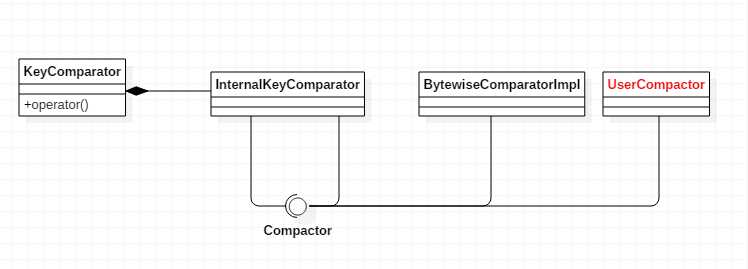
图2.1 Compactor
注:
客户端的删除动作将被转换为一次ValueType为Deletion的添加动作,Compact动作将执行真正的删除:
void MemTable::Add(SequenceNumber s, ValueType type, const Slice& key, const Slice& value)
--->
// Value types encoded as the last component of internal keys. // DO NOT CHANGE THESE ENUM VALUES: they are embedded in the on-disk // data structures. enum ValueType { kTypeDeletion = 0x0, //Deletion必须小于Value,查找时按顺序排列 kTypeValue = 0x1 };
Get时如查找到符合条件的数据为一条删除记录,查找失败:
1 bool MemTable::Get(const LookupKey& key, std::string* value, Status* s) 2 { 3 Slice memkey = key.memtable_key(); 4 5 Table::Iterator iter(&table_); 6 iter.Seek(memkey.data()); 7 8 if (iter.Valid()) { 9 const char* entry = iter.key(); 10 uint32_t key_length; 11 const char* key_ptr = GetVarint32Ptr(entry, entry + 5, &key_length); 12 if (comparator_.comparator.user_comparator()->Compare( 13 Slice(key_ptr, key_length - 8), key.user_key()) == 0) 14 { 15 // Correct user key 16 const uint64_t tag = DecodeFixed64(key_ptr + key_length - 8); 17 switch (static_cast<ValueType>(tag & 0xff)) { 18 case kTypeValue: { 19 Slice v = GetLengthPrefixedSlice(key_ptr + key_length); 20 value->assign(v.data(), v.size()); 21 return true; 22 } 23 case kTypeDeletion: 24 *s = Status::NotFound(Slice()); 25 return true; 26 } 27 } 28 } 29 return false; 30 }
上一节提到的MemTable是内存表,当内存表增长到一定程度时(memtable.size> Options::write_buffer_size),Compact动作会将当前的MemTable数据持久化,持久化的文件(sst文件)称之为SSTable。LevelDB中的SSTable分为不同的层级,这也是LevelDB称之为Level DB的原因,当前版本的最大层级为7(0-6),level-0的数据最新,level-6的数据最旧。除此之外,Compact动作会将多个SSTable合并成少量的几个SSTable,以剔除无效数据,保证数据访问效率并降低磁盘占用。
在存储设备上,一个SSTable被划分为多个Block数据块。每个Block中存储的可能是用户数据、索引数据或任何其他数据。SSTable除Block外,每个Block尾部还带了额外信息,布局如下:
|
Block(数据块) |
Compression Type(是否压缩) |
CRC(数字签名) |
|
Block(数据块) |
Compression Type(是否压缩) |
CRC(数字签名) |
表 3.1 SSTable内部单元
Compression Type标识Block中的数据是否被压缩,采用了何种压缩算法,CRC则是Block的数字签名,用于校验数据的有效性。
Block是SSTable物理布局的关键。来看Block结构:

图3.1 Block的物理布局
Block由以下两部分组成:
l 数据记录:每一个Record代表了一条用户记录(Key-Value对)。严格上讲,并不是完整的用户记录,在Key上Block做了优化。
l 重启点信息:亦即索引信息,用于Record快速定位。如Restart[0]永远指向block的相对偏移0,Restart[1]指向重启点Record4的相对偏移。作者在Key存储上做了优化,每个重启点指向的第一条Record记录了完整的Key值,而本重启点之内的其他key仅包含和前一条的差异项。
让我们通过Block的构建过程了解上述结构:
1 void BlockBuilder::Add(const Slice& key, const Slice& value) { 2 Slice last_key_piece(last_key_); 3 4 assert(!finished_); 5 assert(counter_ <= options_->block_restart_interval); 6 assert(buffer_.empty() || options_->comparator->Compare(key, last_key_piece) > 0); 7 8 //1. 构建Restart Point 9 size_t shared = 0; 10 if (counter_ < options_->block_restart_interval)//配置参数,默认为16 11 { //尚未达到重启点间隔,沿用当前的重启点 12 // See how much sharing to do with previous string 13 const size_t min_length = std::min(last_key_piece.size(), key.size()); 14 while ((shared < min_length) && (last_key_piece[shared] == key[shared])) 15 { 16 shared++; 17 } 18 } 19 else //触发并创建新的重启点 20 { 21 //此时,shared = 0; 重启点中将保存完整key 22 // Restart compression 23 restarts_.push_back(buffer_.size());//buffer_.size()为当前数据块偏移 24 counter_ = 0; 25 } 26 const size_t non_shared = key.size() - shared; 27 28 //2. 记录数据 29 // shared size | no shared size | value size | no shared key data | value data 30 // Add "<shared><non_shared><value_size>" to buffer_ 31 PutVarint32(&buffer_, shared); 32 PutVarint32(&buffer_, non_shared); 33 PutVarint32(&buffer_, value.size()); 34 // Add string delta to buffer_ followed by value 35 buffer_.append(key.data() + shared, non_shared); 36 buffer_.append(value.data(), value.size()); 37 38 // Update state 39 last_key_.resize(shared); 40 last_key_.append(key.data() + shared, non_shared); 41 assert(Slice(last_key_) == key); 42 counter_++; 43 }
代码3.1 BlockBuilder::Add
Buffer_代表当前数据块,restart_中则包含了重启点信息。当向block中新增一条记录时,首先设置重启点信息,包括:是否创建新的重启点,当前key和last key中公共部分大小。重启点信息整理完毕后,插入Record信息,Record信息的结构如下:
Record: shared size | no shared size | value size | no shared key data | value data
表3.2 Record结构
再来看Block构建完成时调用的Finish方法:
1 Slice BlockBuilder::Finish() { 2 // Append restart array 3 for (size_t i = 0; i < restarts_.size(); i++) { 4 PutFixed32(&buffer_, restarts_[i]); 5 } 6 PutFixed32(&buffer_, restarts_.size()); 7 finished_ = true; 8 return Slice(buffer_); 9 }
代码3.2 BlockBuilder::Finish
此处和图3.1一致,在所有Record之后记录重启点信息,包括每条重启点信息(block中相对偏移)及重启点数量。
重启点机制主要有两点好处:
至此,SSTable的物理布局已然清晰,由上到下依次为:表3.1->图3.1->表3.2。
刚刚看过Block的结构,紧接着来看SSTable的逻辑布局,这次我们先从实现说起:
1 void TableBuilder::Add(const Slice& key, const Slice& value) { 2 Rep* r = rep_; 3 assert(!r->closed); 4 if (!ok()) return; 5 if (r->num_entries > 0) { 6 assert(r->options.comparator->Compare(key, Slice(r->last_key)) > 0); 7 } 8 9 //1. 构建Index 10 if (r->pending_index_entry) { 11 assert(r->data_block.empty()); 12 r->options.comparator->FindShortestSeparator(&r->last_key, key); 13 std::string handle_encoding; 14 r->pending_handle.EncodeTo(&handle_encoding); 15 r->index_block.Add(r->last_key, Slice(handle_encoding)); 16 r->pending_index_entry = false; 17 } 18 19 //2. 记录数据 20 r->last_key.assign(key.data(), key.size()); 21 r->num_entries++; 22 r->data_block.Add(key, value); 23 24 //3. 数据块大小已达上限,写入文件 25 const size_t estimated_block_size = r->data_block.CurrentSizeEstimate(); 26 if (estimated_block_size >= r->options.block_size) { 27 Flush(); 28 } 29 }
代码3.3 TableBuilder::Add
这段代码和代码3.1类似,先构建索引,随后插入数据,此处额外增加了数据块处理逻辑:数据块大小达到了指定上限,写入文件。您可能已经注意到,Block中采用了重启点机制实现索引功能,在保证性能的同时又降低了磁盘占用。那么此处为何没有采用类似的机制呢?
实际上,此处索引键值的存储也做了优化,具体实现在FindShortestSeparator中,其目的在于获取最短的可以做为索引的“key”值。举例来说,“helloworld”和”hellozoomer”之间最短的key值可以是”hellox”。除此之外,另一个FindShortSuccessor方法则更极端,用于找到比指定key值大的最小key,如传入“helloworld”,返回的key值可能是“i”而已。作者专门为此抽象了两个接口,放置于Compactor中,可见其对编码也是是有“洁癖”的(*_*)。
1 // A Comparator object provides a total order across slices that are 2 // used as keys in an sstable or a database. A Comparator implementation 3 // must be thread-safe since leveldb may invoke its methods concurrently 4 // from multiple threads. 5 class Comparator { 6 public: 7 ...... 8 // Advanced functions: these are used to reduce the space requirements 9 // for internal data structures like index blocks. 10 11 // If *start < limit, changes *start to a short string in [start,limit). 12 // Simple comparator implementations may return with *start unchanged, 13 // i.e., an implementation of this method that does nothing is correct. 14 virtual void FindShortestSeparator(std::string* start, const Slice& limit) const = 0; 15 16 // Changes *key to a short string >= *key. 17 // Simple comparator implementations may return with *key unchanged, 18 // i.e., an implementation of this method that does nothing is correct. 19 virtual void FindShortSuccessor(std::string* key) const = 0; 20 };
代码3.4 索引键值优化接口
再来看Table构建完成时调用的Finish方法:
1 Status TableBuilder::Finish() { 2 //1. Data Block 3 Rep* r = rep_; 4 Flush(); 5 6 assert(!r->closed); 7 r->closed = true; 8 9 //2. Meta Block 10 BlockHandle metaindex_block_handle; 11 BlockHandle index_block_handle; 12 if (ok()) 13 { 14 BlockBuilder meta_index_block(&r->options); 15 // TODO(postrelease): Add stats and other meta blocks 16 WriteBlock(&meta_index_block, &metaindex_block_handle); 17 } 18 19 //3. Index Block 20 if (ok()) { 21 if (r->pending_index_entry) { 22 r->options.comparator->FindShortSuccessor(&r->last_key); 23 std::string handle_encoding; 24 r->pending_handle.EncodeTo(&handle_encoding); 25 r->index_block.Add(r->last_key, Slice(handle_encoding)); 26 r->pending_index_entry = false; 27 } 28 WriteBlock(&r->index_block, &index_block_handle); 29 } 30 31 //4. Footer 32 if (ok()) 33 { 34 Footer footer; 35 footer.set_metaindex_handle(metaindex_block_handle); 36 footer.set_index_handle(index_block_handle); 37 std::string footer_encoding; 38 footer.EncodeTo(&footer_encoding); 39 r->status = r->file->Append(footer_encoding); 40 if (r->status.ok()) { 41 r->offset += footer_encoding.size(); 42 } 43 } 44 return r->status; 45 }
代码3.5 TableBuilder::Finish
通过Finish方法,我们可以一窥SSTable的全貌:
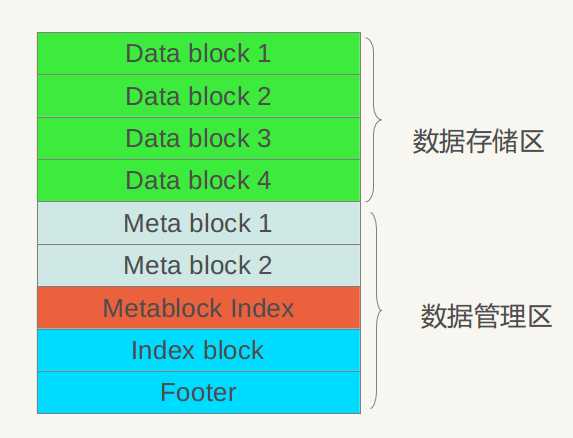
图3.2 SSTable逻辑布局
l Data Block:数据块,用户数据存放于此。
l Meta Block:元数据块,暂未使用,占位而已。
l Index Block:索引块,用于用户数据快速定位。
l Footer:见图3.3,“metaindex_handle指出了metaindex block的起始位置和大小;inex_handle指出了index Block的起始地址和大小;这两个字段可以理解为索引的索引,是为了正确读出索引值而设立的,后面跟着一个填充区和魔数。”(引自数据分析与处理之二(Leveldb 实现原理))。
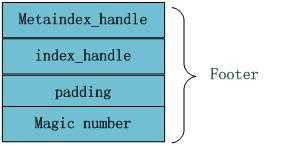
图3.3 Footer
Version、Current File、Manifest等暂未备忘,待后续补充。
标签:
原文地址:http://www.cnblogs.com/desmondwang/p/5021201.html